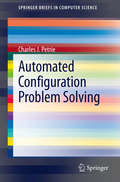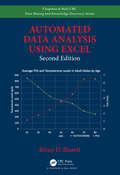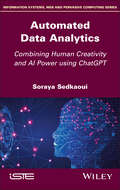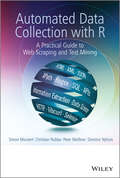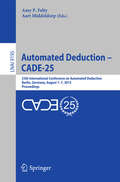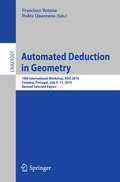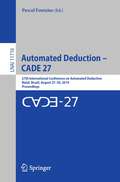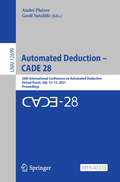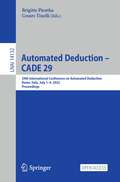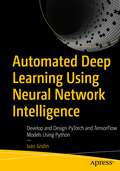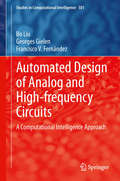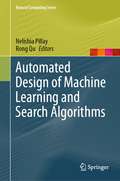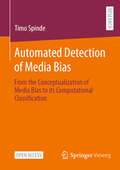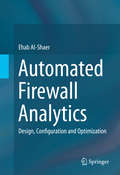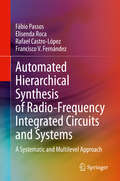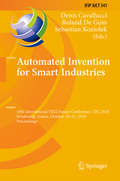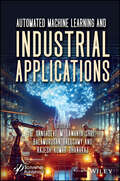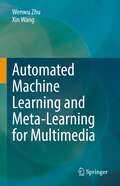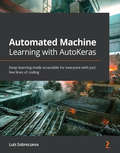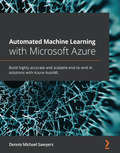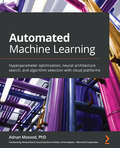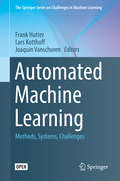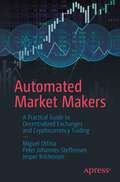- Table View
- List View
Automated Configuration Problem Solving (SpringerBriefs in Computer Science)
by Charles J. PetrieAutomated Configuration has long been the subject of intensive research, especially in Artificial Intelligence. It is a pervasive problem to be solved, and it is a good test of various knowledge representation and reasoning techniques. The problem shows up in applications such as various electrical circuit design, utility computing and even concurrent engineering. Automated Configuration Problem Solving defines the ubiquitous problem, illustrates the various solution techniques, and includes a survey using these techniques from the mid-70's until the mid-90's. During this time, various general approaches were developed, and then become more specialized. This book covers the development of the general problem solving techniques for automated configuration, which are based on both published academic work and patents.
Automated Data Analysis Using Excel (Chapman & Hall/CRC Data Mining and Knowledge Discovery Series)
by Brian D. BissettThis new edition covers some of the key topics relating to the latest version of MS Office through Excel 2019, including the creation of custom ribbons by injecting XML code into Excel Workbooks and how to link Excel VBA macros to customize ribbon objects. It now also provides examples in using ADO, DAO, and SQL queries to retrieve data from databases for analysis. Operations such as fully automated linear and non-linear curve fitting, linear and non-linear mapping, charting, plotting, sorting, and filtering of data have been updated to leverage the newest Excel VBA object models. The text provides examples on automated data analysis and the preparation of custom reports suitable for legal archiving and dissemination. Functionality Demonstrated in This Edition Includes: Find and extract information raw data files Format data in color (conditional formatting) Perform non-linear and linear regressions on data Create custom functions for specific applications Generate datasets for regressions and functions Create custom reports for regulatory agencies Leverage email to send generated reports Return data to Excel using ADO, DAO, and SQL queries Create database files for processed data Create tables, records, and fields in databases Add data to databases in fields or records Leverage external computational engines Call functions in MATLAB® and Origin® from Excel
Automated Data Analytics: Combining Human Creativity and AI Power Using ChatGPT (ISTE Invoiced)
by Soraya SedkaouiThe human mind is endowed with a remarkable capacity for creative synthesis between intuition and reason; this mental alchemy is the source of genius. A new synergy is emerging between human ingenuity and the computational capacity of generative AI models. Automated Data Analytics focuses on this fruitful collaboration between the two to unlock the full potential of data analysis. Together, human ethics and algorithmic productivity have created an alloy stronger than the sum of its parts. The future belongs to this symbiosis between heart and mind, human and machine. If we succeed in harmoniously combining our strengths, it will only be a matter of time before we discover new analytical horizons. This book sets out the foundations of this promising partnership, in which everyone makes their contribution to a common work of considerable scope. History is being forged before our very eyes. It is our responsibility to write it wisely, and to collectively pursue the ideal of augmented intelligence progress.
Automated Data Collection with R: A Practical Guide to Web Scraping and Text Mining
by Simon Munzert Christian Rubba Peter Meißner Dominic NyhuisA hands on guide to web scraping and text mining for both beginners and experienced users of R Introduces fundamental concepts of the main architecture of the web and databases and covers HTTP, HTML, XML, JSON, SQL. Provides basic techniques to query web documents and data sets (XPath and regular expressions). An extensive set of exercises are presented to guide the reader through each technique. Explores both supervised and unsupervised techniques as well as advanced techniques such as data scraping and text management. Case studies are featured throughout along with examples for each technique presented. R code and solutions to exercises featured in the book are provided on a supporting website.
Automated Deduction - CADE-25: 25th International Conference on Automated Deduction, Berlin, Germany, August 1-7, 2015, Proceedings (Lecture Notes in Computer Science #9195)
by Amy P. Felty Aart MiddeldorpThis book constitutes the proceedings of the 25th International Conference on Automated Deduction, CADE-25, held in Berlin, Germany, in August 2015. The 36 revised full papers presented ( 24 full papers and 12 system descriptions) were carefully reviewed and selected from 85 submissions. CADE is the major forum for the presentation of research in all aspects of automated deduction, including foundations, applications, implementations and practical experience.
Automated Deduction in Geometry: 10th International Workshop, ADG 2014, Coimbra, Portugal, July 9-11, 2014, Revised Selected Papers (Lecture Notes in Computer Science #9201)
by Francisco Botana Pedro QuaresmaThis book constitutes the thoroughly refereed post-workshop proceedings of the 10th International Workshop on Automated Deduction in Geometry, ADG 2014, held in Coimbra, Portugal, in July 2014. The 11 revised full papers presented in this volume were carefully selected from 20 submissions. The papers show the trend set of current research in automated reasoning in geometry.
Automated Deduction – CADE 26: 26th International Conference on Automated Deduction, Gothenburg, Sweden, August 6–11, 2017, Proceedings (Lecture Notes in Computer Science #10395)
by Leonardo MouraThis book constitutes the proceeding of the 26th International Conference on Automated Deduction, CADE-26, held in Gothenburg, Sweden, in August 2017. The 26 full papers and 5 system descriptions presented were carefully reviewed and selected from 69 submissions. CADE is the major forum for the presentation of research in all aspects of automated deduction, including foundations, applications, implementations and practical experience. The chapter 'Certifying Confluence of Quasi-Decreasing Strongly Deterministic Conditional Term Rewrite Systems' is published open access under a CC BY 4. 0 license.
Automated Deduction – CADE 27: 27th International Conference on Automated Deduction, Natal, Brazil, August 27–30, 2019, Proceedings (Lecture Notes in Computer Science #11716)
by Pascal FontaineThis book constitutes the proceeding of the 27th International Conference on Automated Deduction, CADE 27, held in Natal, Brazil, in August 2019. The 27 full papers and 7 system descriptions presented were carefully reviewed and selected from 65 submissions. CADE is the major forum for the presentation of research in all aspects of automated deduction, including foundations, applications, implementations, and practical experience.
Automated Deduction – CADE 28: 28th International Conference on Automated Deduction, Virtual Event, July 12–15, 2021, Proceedings (Lecture Notes in Computer Science #12699)
by André Platzer Geoff SutcliffeThis open access book constitutes the proceeding of the 28th International Conference on Automated Deduction, CADE 28, held virtually in July 2021.The 29 full papers and 7 system descriptions presented together with 2 invited papers were carefully reviewed and selected from 76 submissions. CADE is the major forum for the presentation of research in all aspects of automated deduction, including foundations, applications, implementations, and practical experience. The papers are organized in the following topics: Logical foundations; theory and principles; implementation and application; ATP and AI; and system descriptions.
Automated Deduction – CADE 29: 29th International Conference on Automated Deduction, Rome, Italy, July 1–4, 2023, Proceedings (Lecture Notes in Computer Science #14132)
by Cesare Tinelli Brigitte PientkaThis open access book constitutes the proceedings of the 29th International Conference on Automated Deduction, CADE 29, which took place in Rome, Italy, during July 2023. The 28 full papers and 5 short papers presented were carefully reviewed and selected from 77 submissions. CADE is the major forum for the presentation of research in all aspects of automated deduction, including foundations, applications, implementations, and practical experience. The papers are organized in the following topics: Logical foundations; theory and principles; implementation and application; ATP and AI; and system descriptions.
Automated Deep Learning Using Neural Network Intelligence: Develop and Design PyTorch and TensorFlow Models Using Python
by Ivan GridinOptimize, develop, and design PyTorch and TensorFlow models for a specific problem using the Microsoft Neural Network Intelligence (NNI) toolkit. This book includes practical examples illustrating automated deep learning approaches and provides techniques to facilitate your deep learning model development. The first chapters of this book cover the basics of NNI toolkit usage and methods for solving hyper-parameter optimization tasks. You will understand the black-box function maximization problem using NNI, and know how to prepare a TensorFlow or PyTorch model for hyper-parameter tuning, launch an experiment, and interpret the results. The book dives into optimization tuners and the search algorithms they are based on: Evolution search, Annealing search, and the Bayesian Optimization approach. The Neural Architecture Search is covered and you will learn how to develop deep learning models from scratch. Multi-trial and one-shot searching approaches of automatic neural network design are presented. The book teaches you how to construct a search space and launch an architecture search using the latest state-of-the-art exploration strategies: Efficient Neural Architecture Search (ENAS) and Differential Architectural Search (DARTS). You will learn how to automate the construction of a neural network architecture for a particular problem and dataset. The book focuses on model compression and feature engineering methods that are essential in automated deep learning. It also includes performance techniques that allow the creation of large-scale distributive training platforms using NNI. After reading this book, you will know how to use the full toolkit of automated deep learning methods. The techniques and practical examples presented in this book will allow you to bring your neural network routines to a higher level.What You Will LearnKnow the basic concepts of optimization tuners, search space, and trialsApply different hyper-parameter optimization algorithms to develop effective neural networksConstruct new deep learning models from scratchExecute the automated Neural Architecture Search to create state-of-the-art deep learning modelsCompress the model to eliminate unnecessary deep learning layersWho This Book Is For Intermediate to advanced data scientists and machine learning engineers involved in deep learning and practical neural network development
Automated Design of Analog and High-frequency Circuits: A Computational Intelligence Approach (Studies in Computational Intelligence #501)
by Bo Liu Georges Gielen Francisco V. FernándezComputational intelligence techniques are becoming more and more important for automated problem solving nowadays. Due to the growing complexity of industrial applications and the increasingly tight time-to-market requirements, the time available for thorough problem analysis and development of tailored solution methods is decreasing. There is no doubt that this trend will continue in the foreseeable future. Hence, it is not surprising that robust and general automated problem solving methods with satisfactory performance are needed.
Automated Design of Machine Learning and Search Algorithms (Natural Computing Series)
by Nelishia Pillay Rong QuThis book presents recent advances in automated machine learning (AutoML) and automated algorithm design and indicates the future directions in this fast-developing area. Methods have been developed to automate the design of neural networks, heuristics and metaheuristics using techniques such as metaheuristics, statistical techniques, machine learning and hyper-heuristics. The book first defines the field of automated design, distinguishing it from the similar but different topics of automated algorithm configuration and automated algorithm selection. The chapters report on the current state of the art by experts in the field and include reviews of AutoML and automated design of search, theoretical analyses of automated algorithm design, automated design of control software for robot swarms, and overfitting as a benchmark and design tool. Also covered are automated generation of constructive and perturbative low-level heuristics, selection hyper-heuristics for automated design, automated design of deep-learning approaches using hyper-heuristics, genetic programming hyper-heuristics with transfer knowledge and automated design of classification algorithms. The book concludes by examining future research directions of this rapidly evolving field. The information presented here will especially interest researchers and practitioners in the fields of artificial intelligence, computational intelligence, evolutionary computation and optimisation.
Automated Detection of Media Bias: From the Conceptualization of Media Bias to its Computational Classification
by Timo SpindeThis Open Access book explores the automated identification of media bias, particularly focusing on bias by word choice in digital media. The increasing prevalence of digital information presents opportunities and challenges for analyzing language, with cultural, geographic, and contextual factors shaping how content is portrayed. Despite the interdisciplinary nature of media bias research across fields like linguistics, psychology, and computer science, existing work often tackles the problem from limited perspectives, lacking comprehensive frameworks and reliable datasets. The book aims to advance the field by addressing these gaps and proposing a systematic approach to media bias detection. It develops feature-based and deep-learning approaches for automated bias detection, including a BERT-based model and MAGPIE, a multi-task learning model. These methods demonstrate improved performance on established benchmarks, showcasing the potential of deep learning in detecting media bias. Finally, the author addresses the practical applications of automated bias detection, such as enhancing news reading with forewarning messages, text annotations, and political classifiers, and examines the impact of bias on social media engagement.
Automated Firewall Analytics: Design, Configuration and Optimization
by Ehab Al-ShaerThis book provides a comprehensive and in-depth study of automated firewall policy analysis for designing, configuring and managing distributed firewalls in large-scale enterpriser networks. It presents methodologies, techniques and tools for researchers as well as professionals to understand the challenges and improve the state-of-the-art of managing firewalls systematically in both research and application domains. Chapters explore set-theory, managing firewall configuration globally and consistently, access control list with encryption, and authentication such as IPSec policies. The author also reveals a high-level service-oriented firewall configuration language (called FLIP) and a methodology and framework for designing optimal distributed firewall architecture. The chapters illustrate the concepts, algorithms, implementations and case studies for each technique. Automated Firewall Analytics: Design, Configuration and Optimization is appropriate for researchers and professionals working with firewalls. Advanced-level students in computer science will find this material suitable as a secondary textbook or reference.
Automated Hierarchical Synthesis of Radio-Frequency Integrated Circuits and Systems: A Systematic and Multilevel Approach
by Elisenda Roca Francisco V. Fernández Fábio Passos Rafael Castro-LópezThis book describes a new design methodology that allows optimization-based synthesis of RF systems in a hierarchical multilevel approach, in which the system is designed in a bottom-up fashion, from the device level up to the (sub)system level. At each level of the design hierarchy, the authors discuss methods that increase the design robustness and increase the accuracy and efficiency of the simulations. The methodology described enables circuit sizing and layout in a complete and automated integrated manner, achieving optimized designs in significantly less time than with traditional approaches.
Automated Invention for Smart Industries: 18th International TRIZ Future Conference, TFC 2018, Strasbourg, France, October 29–31, 2018, Proceedings (IFIP Advances in Information and Communication Technology #541)
by Roland De Guio Denis Cavallucci Sebastian KoziołekThis book constitutes the refereed proceedings of the 18th International TRIZ Future Conference on Automated Invention for Smart Industries, held in Strasbourg, France, in October 2018 and sponsored by IFIP WG 5.4.The 27 full papers presented were carefully reviewed and selected from numerous submissions. They are organized in seven thematic sections: teaching of TRIZ; TRIZ and knowledge represenations; biomimicry; strategic company management; association between TRIZ and other methods; TRIZ and the functional approach; and the use of patent or text populations as a data source.
Automated Machine Learning and Industrial Applications
by Balamurugan Balusamy Rajesh Kumar Dhanaraj M. Lawanya Shri E. GangadeviThe book provides a comprehensive understanding of Automated Machine Learning’s transformative potential across various industries, empowering users to seamlessly implement advanced machine learning solutions without needing extensive expertise. Automated Machine Learning (AutoML) is a process to automate the responsibilities of machine learning concepts for real-world problems. The AutoML process is comprised of all steps, beginning with a raw dataset and concluding with the construction of a machine learning model for deployment. The purpose of AutoML is to allow non-experts to work with machine learning models and techniques without requiring much knowledge in machine learning. This advancement enables data scientists to produce the easiest solutions and most accurate results within a short timeframe, allowing them to outperform normal machine learning models. Meta-learning, neural network architecture, and hyperparameter optimization, are applied based on AutoML. Automated Machine Learning and Industrial Applications offers an overview of the basic architecture, evolution, and applications of AutoML. Potential applications in healthcare, banking, agriculture, aerospace, and security are discussed in terms of their frameworks, implementation, and evaluation. This book also explores the AutoML ecosystem, its integration with blockchain, and various open-source tools available on the AutoML platform. It serves as a practical guide for engineers and data scientists, offering valuable insights for decision-makers looking to integrate machine learning into their workflows. Readers will find the book: Aims to explore current trends such as augmented reality, virtual reality, blockchain, open-source platforms, and Industry 4.0; Serves as an effective guide for professionals, researchers, industrialists, data scientists, and application developers; Explores technologies such as IoT, blockchain, artificial intelligence, and robotics, serving as a core guide for undergraduate and postgraduate students. Audience Data and computer scientists, research scholars, professionals, and industrialists interested in technology for Industry 4.0 applications.
Automated Machine Learning and Meta-Learning for Multimedia
by Xin Wang Wenwu ZhuThis book disseminates and promotes the recent research progress and frontier development on AutoML and meta-learning as well as their applications on computer vision, natural language processing, multimedia and data mining related fields. These are exciting and fast-growing research directions in the general field of machine learning. The authors advocate novel, high-quality research findings, and innovative solutions to the challenging problems in AutoML and meta-learning. This topic is at the core of the scope of artificial intelligence, and is attractive to audience from both academia and industry.This book is highly accessible to the whole machine learning community, including: researchers, students and practitioners who are interested in AutoML, meta-learning, and their applications in multimedia, computer vision, natural language processing and data mining related tasks. The book is self-contained and designed for introductory and intermediate audiences. No special prerequisite knowledge is required to read this book.
Automated Machine Learning on AWS: Fast-track the development of your production-ready machine learning applications the AWS way
by Trenton Potgieter Jonathan DahlbergAutomate the process of building, training, and deploying machine learning applications to production with AWS solutions such as SageMaker Autopilot, AutoGluon, Step Functions, Amazon Managed Workflows for Apache Airflow, and moreKey FeaturesExplore the various AWS services that make automated machine learning easierRecognize the role of DevOps and MLOps methodologies in pipeline automationGet acquainted with additional AWS services such as Step Functions, MWAA, and more to overcome automation challengesBook DescriptionAWS provides a wide range of solutions to help automate a machine learning workflow with just a few lines of code. With this practical book, you'll learn how to automate a machine learning pipeline using the various AWS services. Automated Machine Learning on AWS begins with a quick overview of what the machine learning pipeline/process looks like and highlights the typical challenges that you may face when building a pipeline. Throughout the book, you'll become well versed with various AWS solutions such as Amazon SageMaker Autopilot, AutoGluon, and AWS Step Functions to automate an end-to-end ML process with the help of hands-on examples. The book will show you how to build, monitor, and execute a CI/CD pipeline for the ML process and how the various CI/CD services within AWS can be applied to a use case with the Cloud Development Kit (CDK). You'll understand what a data-centric ML process is by working with the Amazon Managed Services for Apache Airflow and then build a managed Airflow environment. You'll also cover the key success criteria for an MLSDLC implementation and the process of creating a self-mutating CI/CD pipeline using AWS CDK from the perspective of the platform engineering team. By the end of this AWS book, you'll be able to effectively automate a complete machine learning pipeline and deploy it to production.What you will learnEmploy SageMaker Autopilot and Amazon SageMaker SDK to automate the machine learning processUnderstand how to use AutoGluon to automate complicated model building tasksUse the AWS CDK to codify the machine learning processCreate, deploy, and rebuild a CI/CD pipeline on AWSBuild an ML workflow using AWS Step Functions and the Data Science SDKLeverage the Amazon SageMaker Feature Store to automate the machine learning software development life cycle (MLSDLC)Discover how to use Amazon MWAA for a data-centric ML processWho this book is forThis book is for the novice as well as experienced machine learning practitioners looking to automate the process of building, training, and deploying machine learning-based solutions into production, using both purpose-built and other AWS services. A basic understanding of the end-to-end machine learning process and concepts, Python programming, and AWS is necessary to make the most out of this book.
Automated Machine Learning with AutoKeras: Deep learning made accessible for everyone with just few lines of coding
by Luis SobrecuevaCreate better and easy-to-use deep learning models with AutoKerasKey FeaturesDesign and implement your own custom machine learning models using the features of AutoKerasLearn how to use AutoKeras for techniques such as classification, regression, and sentiment analysisGet familiar with advanced concepts as multi-modal, multi-task, and search space customizationBook DescriptionAutoKeras is an AutoML open-source software library that provides easy access to deep learning models. If you are looking to build deep learning model architectures and perform parameter tuning automatically using AutoKeras, then this book is for you. This book teaches you how to develop and use state-of-the-art AI algorithms in your projects. It begins with a high-level introduction to automated machine learning, explaining all the concepts required to get started with this machine learning approach. You will then learn how to use AutoKeras for image and text classification and regression. As you make progress, you'll discover how to use AutoKeras to perform sentiment analysis on documents. This book will also show you how to implement a custom model for topic classification with AutoKeras. Toward the end, you will explore advanced concepts of AutoKeras such as working with multi-modal data and multi-task, customizing the model with AutoModel, and visualizing experiment results using AutoKeras Extensions. By the end of this machine learning book, you will be able to confidently use AutoKeras to design your own custom machine learning models in your company.What you will learnSet up a deep learning workstation with TensorFlow and AutoKerasAutomate a machine learning pipeline with AutoKerasCreate and implement image and text classifiers and regressors using AutoKerasUse AutoKeras to perform sentiment analysis of a text, classifying it as negative or positiveLeverage AutoKeras to classify documents by topicsMake the most of AutoKeras by using its most powerful extensionsWho this book is forThis book is for machine learning and deep learning enthusiasts who want to apply automated ML techniques to their projects. Prior basic knowledge of Python programming and machine learning is expected to get the most out of this book.
Automated Machine Learning with Microsoft Azure: Build highly accurate and scalable end-to-end AI solutions with Azure AutoML
by Dennis Michael SawyersA practical, step-by-step guide to using Microsoft's AutoML technology on the Azure Machine Learning service for developers and data scientists working with the Python programming languageKey FeaturesCreate, deploy, productionalize, and scale automated machine learning solutions on Microsoft AzureImprove the accuracy of your ML models through automatic data featurization and model trainingIncrease productivity in your organization by using artificial intelligence to solve common problemsBook DescriptionAutomated Machine Learning with Microsoft Azure helps you to build high-performing, accurate machine learning models in record time. It allows anyone to easily harness the power of artificial intelligence and increase the productivity and profitability of your business. With a series of clicks on a guided user interface (GUI), novices and seasoned data scientists alike can train and deploy machine learning solutions to production with ease. This book will teach you how to use Azure AutoML with both the GUI as well as the AzureML Python software development kit (SDK) in a careful, step-by-step way. First, you'll learn how to prepare data, train models, and register them to your Azure Machine Learning workspace. You'll then discover how to take those models and use them to create both automated batch solutions using machine learning pipelines and real-time scoring solutions using Azure Kubernetes Service (AKS). Finally, you will be able to use AutoML on your own data to not only train regression, classification, and forecasting models but also use them to solve a wide variety of business problems. By the end of this Azure book, you'll be able to show your business partners exactly how your ML models are making predictions through automatically generated charts and graphs, earning their trust and respect.What you will learnUnderstand how to train classification, regression, and forecasting ML algorithms with Azure AutoMLPrepare data for Azure AutoML to ensure smooth model training and deploymentAdjust AutoML configuration settings to make your models as accurate as possibleDetermine when to use a batch-scoring solution versus a real-time scoring solutionProductionalize your AutoML solution with Azure Machine Learning pipelinesCreate real-time scoring solutions with AutoML and Azure Kubernetes ServiceDiscover how to quickly deliver value and earn business trust using AutoMLTrain a large number of AutoML models at once using the AzureML Python SDKWho this book is forData scientists, aspiring data scientists, machine learning engineers, or anyone interested in applying artificial intelligence or machine learning in their business will find this book useful. You need to have beginner-level knowledge of artificial intelligence and a technical background in computer science, statistics, or information technology before getting started with this machine learning book. Familiarity with Python will help you implement this book's more advanced features, but even data analysts and SQL experts will be able to train ML models after finishing this book.
Automated Machine Learning: Hyperparameter optimization, neural architecture search, and algorithm selection with cloud platforms
by Adnan Masood Ahmed SherifGet to grips with automated machine learning and adopt a hands-on approach to AutoML implementation and associated methodologiesKey FeaturesGet up to speed with AutoML using OSS, Azure, AWS, GCP, or any platform of your choiceEliminate mundane tasks in data engineering and reduce human errors in machine learning modelsFind out how you can make machine learning accessible for all users to promote decentralized processesBook DescriptionEvery machine learning engineer deals with systems that have hyperparameters, and the most basic task in automated machine learning (AutoML) is to automatically set these hyperparameters to optimize performance. The latest deep neural networks have a wide range of hyperparameters for their architecture, regularization, and optimization, which can be customized effectively to save time and effort. This book reviews the underlying techniques of automated feature engineering, model and hyperparameter tuning, gradient-based approaches, and much more. You'll discover different ways of implementing these techniques in open source tools and then learn to use enterprise tools for implementing AutoML in three major cloud service providers: Microsoft Azure, Amazon Web Services (AWS), and Google Cloud Platform. As you progress, you'll explore the features of cloud AutoML platforms by building machine learning models using AutoML. The book will also show you how to develop accurate models by automating time-consuming and repetitive tasks in the machine learning development lifecycle. By the end of this machine learning book, you'll be able to build and deploy AutoML models that are not only accurate, but also increase productivity, allow interoperability, and minimize feature engineering tasks.What you will learnExplore AutoML fundamentals, underlying methods, and techniquesAssess AutoML aspects such as algorithm selection, auto featurization, and hyperparameter tuning in an applied scenarioFind out the difference between cloud and operations support systems (OSS)Implement AutoML in enterprise cloud to deploy ML models and pipelinesBuild explainable AutoML pipelines with transparencyUnderstand automated feature engineering and time series forecastingAutomate data science modeling tasks to implement ML solutions easily and focus on more complex problemsWho this book is forCitizen data scientists, machine learning developers, artificial intelligence enthusiasts, or anyone looking to automatically build machine learning models using the features offered by open source tools, Microsoft Azure Machine Learning, AWS, and Google Cloud Platform will find this book useful. Beginner-level knowledge of building ML models is required to get the best out of this book. Prior experience in using Enterprise cloud is beneficial.
Automated Machine Learning: Methods, Systems, Challenges (The Springer Series on Challenges in Machine Learning)
by Lars Kotthoff Joaquin Vanschoren Frank HutterThis open access book presents the first comprehensive overview of general methods in Automated Machine Learning (AutoML), collects descriptions of existing systems based on these methods, and discusses the first series of international challenges of AutoML systems. The recent success of commercial ML applications and the rapid growth of the field has created a high demand for off-the-shelf ML methods that can be used easily and without expert knowledge. However, many of the recent machine learning successes crucially rely on human experts, who manually select appropriate ML architectures (deep learning architectures or more traditional ML workflows) and their hyperparameters. To overcome this problem, the field of AutoML targets a progressive automation of machine learning, based on principles from optimization and machine learning itself. This book serves as a point of entry into this quickly-developing field for researchers and advanced students alike, as well as providing a reference for practitioners aiming to use AutoML in their work.
Automated Market Makers: A Practical Guide to Decentralized Exchanges and Cryptocurrency Trading
by Miguel Ottina Peter Johannes Steffensen Jesper KristensenExplore Automated Market Makers (AMMs), the underlying protocols used by decentralized exchanges (DEX) to allow users to perform trades of cryptocurrencies in a decentralized way with no middlemen. This book provides a thorough study and a clear-cut exposition of the principal AMMs (Uniswap v2 and v3, Balancer, and Curve).You'll receive a detailed description of how these AMMs work, unveiling the mathematics behind them and showing plenty of examples as well as novel proofs for several interesting facts. Each chapter describes an AMM's core idea and derives the mathematical formulas used in the code, giving careful explanations of the logical thinking involved and detailing the steps needed to reach those formulas. All these explanations are complemented with thoughtfully chosen examples which further help to enlighten the readers on how the formulae work. In addition, the relevant parts of the codes of the AMMs are shown after explaining each formula so that the actual implementation of the formulae can be seen.In a traditional trading market a buy order has to be matched with a sell order to achieve a trade. However, for an AMM, users trade against the protocol itself, a smart contract, or a community pool of funds. In simple terms this is an open source computer program in which mathematical formulas define prices. Automated Market Makers examines this critical point revealing that no banks or intermediaries are necessary, giving crucial financial access to a much larger crowd, regardless of who they are with less barriers to access.What You'll LearnUnderstand the principals of decentralized finance (DeFi)Grasp mathematical formulae that underpin decentralized exchangesWork with Solidity programming languageReview current industry best practices Who This Book Is ForThose new to Blockchain and Cryptocurrency trading, who want to learn more about AMMsDevelopers who want to dive deeper into the core features of AMM platformsInvestors and venture capitalists who want to know more about new emerging technologies
